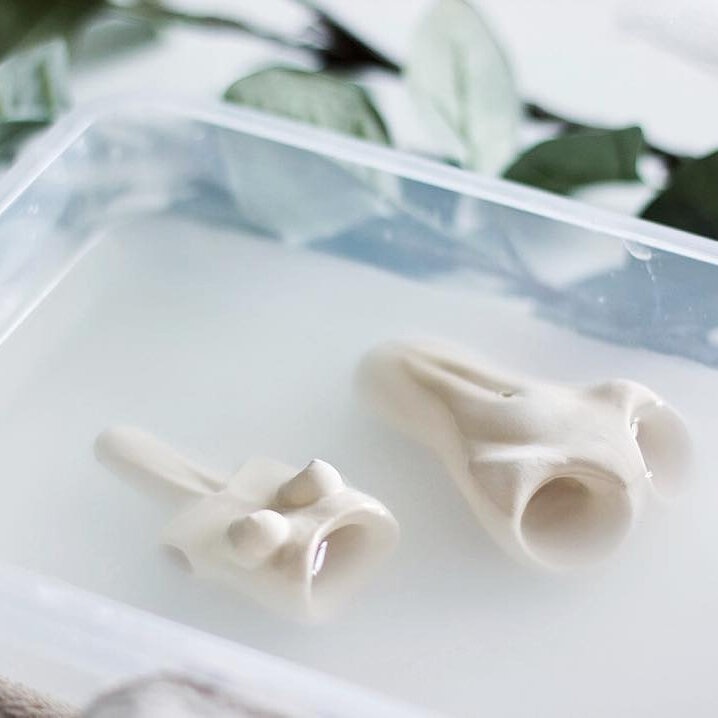Firing porcelain dolls in the kiln
This is probably the most requested article since I’ve started making porcelain dolls. The truth is, I’m still learning myself. I have maybe fifty firings under my belt and not all of them were successful, haha. But I know how sparse the information about firing porcelain dolls is. So maybe we can learn together at the same time? That being said, take all this information with a grain of salt, it might be a nice introduction, but it’s not a professional guide. If you have any insights, feel free to share them in the comments below!
The kiln
To fire porcelain dolls - you’ll need a kiln. If you’re just starting out, I suggest finding a local ceramics class or a friendly artist who will let you try firing something for the first time. The kiln itself can be a big investment, and if you will not stick to this art form, purchasing the kiln yourself is not very wise.
I’m using a small electric Kittec Studio Line 20 Toploader kiln. Since porcelain dolls are quite small, I really like the size of this kiln. It nicely fits into my studio and doesn’t require huge amounts of electricity. I purchased it from the local supplier here in Lithuania, but I’m sure you can find similar kilns all over the world.
Another thing to have in mind before purchasing the kiln is the space. You can’t really have one in your apartment, even though modern electric kilns are very safe, it’s still a fire hazard. When firing glazes or even China paints, it emits fumes that can be hazardous for you and your neighbours’ health. So good ventilation is also required. That’s why you’ll need a studio space or have some room in your garage or shed.
Temperatures and timelines
Firing temperatures are always specified by porcelain suppliers so always read labels or ask when purchasing materials. All porcelains are slightly different in their composition, so firing temperatures can vary a little bit. I’m using Ultra Chic porcelain slip which has a firing temperature of 1220 degrees Celsius (~2230 degrees Fahrenheit). Electric kilns usually have a timer that you can program to reach the required temperature in a certain amount of hours. The person who taught me how to use the kiln I have, recommended to fire porcelain slowly and steadily, so I’m using these programs:
Bisque firing
Bisque firing (sometimes referred to as soft firing) is the first firing that porcelain undergoes. After that, it’s still brittle and very porous, but you can handle it easier. At this stage, you’ll remove all the imperfections, sand and clean the seams, carve small details, etc. Have in mind that all this sanding is happening using a water bath. Porcelain dust is very harmful to your lungs, so keep the bisque wet and your workspace clean.
Bisque firing is usually about 750°C (now, after doing more research and some helpful lessons/comments, I do around 900°C) Raise the temperature slowly and steadily by 120°C every hour until 600°C. Then the kiln automatically accelerates the process and raises the temperature rapidly to 750°C in about 15 minutes. The cooling process can take about 8 hours and just then you can open the kiln and retrieve your pieces.
Final firing
The final firing is the stage when porcelain hardens completely and reaches its final form and colour.
Raise the firing temperature slow and steady by 120°C every hour until 600°C, then rapidly raise the temperature to 1220°C (in about 30-40minutes) and soak for 10 minutes (meaning keep the final temperature of 1220°C for 10 minutes). This kind of firing program takes about 6 hours. After that, the kiln shuts itself off and cools for about 8 hours. Then you can open it and see the final result.
Firing China paints
Porcelain dolls are rarely glazed but for painting, you can use China paints which need to be fired in the kiln as well. Temperatures for China paints can vary as well so always ask your supplier. I’m firing mine to 680°C - 715°C and using the same program as bisque firing.
Common issues and how to avoid them
Firing can be a very fussy process and requires a lot of testing. Even if you read all the information that is available out there, some issues will occur inevitably. Take it as very valuable lessons and keep the firing journal to register firing temperatures, results, issues until you’ll find what works for you. Here are some common issues and how to avoid them:
Black speckles
This happened to me once and was a result of underfiring porcelain before firing China paints. Specking and impurities can occur for a lot of reasons, for example, contamination with iron minerals, not enough oxygen in the kiln, underfiring. To avoid these impurities make sure that you store your slip correctly, use only distilled water to thin out the slip, don’t overload the kiln to keep oxygen flowing freely and fire to the right temperatures.
Cracked pieces
Cracks and fractures can occur for various reasons as well. Usually, it happens when you raise kiln temperature too fast and the water boils too fast causing tiny explosions in your porcelain piece. It can stick to the shelf of the kiln and crack when porcelain starts to shrink. Uneven thickness of porcelain can be a factor as well. To avoid these issues, make sure that you firing porcelain slowly, add silica sand on the shelf if your porcelain pieces sticking and it should help.
Warping
Since porcelain dolls are hollow, warping is a common and irritating issue. I find that stuffing the pieces with ceramic wool (high-temperature insulating fiber) can prevent warping. Keeping the thickness even in all your pieces is very important as well. Firing too high can be another reason for warping.
I hope this overview was helpful. Since I’m still learning a lot every time I use the kiln I probably continue to share my knowledge with you in future articles. It’s a long process and perfecting your techniques can take years. Let me know if you have any questions, I’m happy to help.









